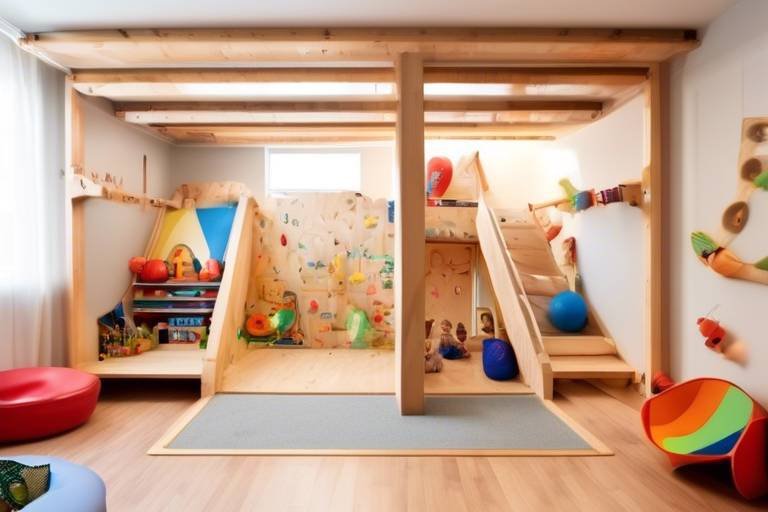The Role of Regular Family Meetings
In today's fast-paced world, where everyone seems to be juggling multiple responsibilities, it's easy for families to drift apart. That's where regular family meetings come into play. These gatherings are not just another item on your to-do list; they are a powerful tool for enhancing communication, resolving conflicts, and reinforcing family bonds. Imagine a space where every voice matters, where laughter and ideas flow freely, and where everyone feels valued. Sounds appealing, right? Well, that's precisely what family meetings can offer!
Family meetings create a unique opportunity to step away from the chaos of daily life and focus on what truly matters: each other. During these meetings, family members can discuss important topics, share updates, and even plan fun activities together. Think of it as a family huddle, where everyone can strategize on how to tackle the challenges of life as a unit. This isn’t just about logistics; it’s about building a supportive environment where each member feels connected and understood.
Moreover, regular family meetings can significantly improve the overall family dynamic. When families communicate openly, misunderstandings diminish, and conflicts can be resolved more amicably. This process not only fosters a sense of teamwork but also cultivates an atmosphere of trust and respect. Children learn the importance of sharing their thoughts and feelings, while adults can model effective communication skills. In essence, these gatherings can transform your family into a cohesive unit, ready to face the world together.
To illustrate the impact of family meetings, consider the following benefits:
- Enhanced Communication: Regular discussions encourage open dialogue, making it easier for family members to express their feelings and thoughts.
- Conflict Resolution: Addressing issues in a structured setting can help resolve conflicts before they escalate.
- Stronger Relationships: Spending quality time together strengthens the bonds between family members, fostering deeper connections.
So, if you're looking to transform your family's dynamics and create a more harmonious home environment, consider implementing regular family meetings. They are not just a trend; they are a necessity for nurturing relationships and building a solid foundation for the future. Ready to dive into the specifics of how to make these meetings effective? Let's explore the benefits of family meetings in more detail!

Benefits of Family Meetings
Regular family meetings are like the secret sauce that can transform the dynamics within your home. Imagine a space where everyone feels heard, valued, and connected. That's what these gatherings can create! One of the most significant benefits of family meetings is improved communication. When family members come together to discuss their thoughts and feelings, it fosters an environment of openness. No more shouting over each other or misunderstandings that linger like a bad smell. Instead, everyone gets a chance to share their views, leading to a deeper understanding of one another.
Moreover, family meetings serve as an excellent platform for conflict resolution. Let’s face it, disagreements are part of family life. However, when you have a regular meeting scheduled, it becomes easier to address issues before they escalate. Think of it as a safety valve that prevents pressure from building up. When conflicts are discussed openly, families can find solutions together, reinforcing their bonds rather than allowing misunderstandings to create rifts.
Another remarkable benefit is enhanced teamwork. Just like a sports team needs to strategize to win, families can benefit from working together toward common goals. During meetings, families can discuss upcoming events, plan vacations, or even tackle household chores as a unit. This collaborative spirit not only improves efficiency but also creates a sense of achievement when tasks are completed together. It's like being part of a winning team where everyone plays a crucial role!
Additionally, family meetings can help in nurturing emotional intelligence among family members. By encouraging everyone to express their feelings and listen to others, kids learn valuable skills that they can carry into their adult lives. They become more empathetic and better communicators, which are essential traits in today’s world. This emotional growth is invaluable, as it lays the groundwork for healthy relationships outside the family unit.
In summary, the benefits of regular family meetings are vast and impactful. Here’s a quick recap of the key advantages:
- Improved communication: Open discussions lead to better understanding.
- Conflict resolution: Addressing issues before they escalate.
- Enhanced teamwork: Collaborating on tasks and goals.
- Nurturing emotional intelligence: Developing empathy and communication skills.
By establishing a routine of family meetings, you not only strengthen your family bonds but also create a supportive environment where everyone can thrive. So, why not give it a try? You might be surprised by the positive changes that unfold!

Establishing a Meeting Routine
Creating a consistent schedule for family meetings is essential for making them a priority in your household. Think of it as setting a date with your family—something everyone looks forward to. When you establish a routine, it signals to every member that these gatherings are important and worth their time. But how do you go about it? It’s not just about picking a day; it’s about creating an environment where everyone feels they can contribute. You might start by discussing potential times that work for everyone. Whether it's a cozy Sunday afternoon or a weekday evening after dinner, the key is to find a slot that aligns with your family’s rhythm.
Once you’ve settled on a time, consider making it a recurring event. Just like your favorite TV show, having a set schedule allows family members to anticipate these meetings. You could even create a family calendar that marks these meetings, reinforcing their importance. To keep things fresh and engaging, you might rotate the responsibility of leading the meeting among family members. This gives everyone a chance to take ownership and brings a unique perspective to each gathering. Imagine the excitement when your teenager gets to plan the agenda for the next meeting—it's a great way to keep everyone invested!
Moreover, setting a specific format can also help. Will you start each meeting with a fun family quiz or a round of sharing highlights from the week? Establishing a routine doesn't have to be rigid; it can be as flexible as your family needs it to be. The goal is to create a warm, inviting atmosphere where everyone feels comfortable sharing their thoughts. Remember, these meetings should be a safe space, not a chore. When family members know what to expect, they are more likely to engage actively and contribute meaningfully to discussions.
In addition, consider the logistics of your meetings. Make sure everyone has access to the meeting space, whether it’s the kitchen table or the living room couch. A comfortable setting can make a world of difference in how open people feel about sharing. You might even want to set up a “snack corner” to make it feel more like a family gathering than a formal meeting. After all, who doesn’t love some popcorn or cookies while discussing important family matters?
Lastly, it’s crucial to regularly revisit the routine itself. As your family grows and changes, so too may your meeting needs. Perhaps your children will have different schedules as they enter new phases of life, or maybe your family dynamic will shift. Keeping an open line of communication about the meeting routine will ensure it continues to serve everyone well. Ask for feedback and be willing to adapt. This flexibility shows that you value each member's input, reinforcing the bonds that family meetings aim to strengthen.
- How often should we hold family meetings? The frequency can vary based on your family's needs. Some families benefit from weekly meetings, while others may find monthly gatherings more suitable.
- What should we talk about during family meetings? Topics can range from planning family outings to discussing any issues or challenges that need addressing. It's a space for open dialogue.
- What if a family member doesn't want to participate? Encourage participation by creating a welcoming environment and reminding them that their voice matters. You might also consider one-on-one discussions to understand their hesitations.

Choosing the Right Frequency
Establishing the right frequency for family meetings is a pivotal step in ensuring these gatherings are both effective and beneficial. Think of it like tuning a musical instrument; if you don’t get the frequency just right, the harmony can quickly turn into discord. The ideal frequency will vary from family to family, influenced by several factors such as family size, individual schedules, and the specific communication needs within the household.
For instance, a family with young children may benefit from more frequent meetings, perhaps on a weekly basis, to keep everyone on the same page and to address any immediate concerns. On the other hand, a family with teenagers might find that monthly meetings are sufficient, allowing for more independence while still providing a platform for discussion. It’s essential to strike a balance that works for everyone involved.
To help you determine the best frequency for your family, consider the following:
- Family Size: Larger families may require more frequent meetings to ensure that every voice is heard, while smaller families may find it easier to communicate more spontaneously.
- Schedules: Busy schedules can be a significant barrier. Look at everyone’s commitments and find a rhythm that fits into your lives without feeling forced or rushed.
- Communication Needs: If your family is facing challenges, such as conflicts or significant changes, more frequent meetings may be necessary to navigate these issues effectively.
Ultimately, the goal is to create a routine that everyone can commit to, making family meetings a natural part of your lives rather than a chore. Remember, it’s not just about how often you meet, but the quality of those interactions that truly matters. Don’t hesitate to reassess and adjust the frequency as your family dynamics evolve. After all, flexibility is key in maintaining a supportive and communicative family environment.

Weekly vs. Monthly Meetings
When it comes to family meetings, one of the most common dilemmas is deciding on the frequency. Should you gather around the dinner table every week or is once a month enough? The answer isn't one-size-fits-all; it largely depends on your family's unique dynamics and needs. Weekly meetings can serve as a fantastic opportunity for families to stay connected and address issues promptly. Imagine it as a regular check-in, much like tuning a musical instrument to ensure it plays harmoniously. Regular discussions can help prevent misunderstandings from escalating into larger conflicts, making it easier to maintain a positive family atmosphere.
On the other hand, monthly meetings might be more suitable for families with packed schedules. This option allows time for meaningful discussions without the pressure of weekly commitments. Think of it as a special occasion, like a family reunion, where everyone can come together to share updates and celebrate achievements. Monthly meetings can provide a broader perspective on family matters, allowing for deeper conversations and reflections on what has transpired over the past weeks.
To help you weigh the pros and cons, here’s a quick comparison:
| Frequency | Pros | Cons |
|---|---|---|
| Weekly |
|
|
| Monthly |
|
|
Ultimately, the choice between weekly and monthly meetings boils down to your family's lifestyle and preferences. Some families thrive on routine and find that weekly gatherings keep them engaged and informed, while others may prefer the more leisurely pace of monthly meetings. It’s all about finding that sweet spot that works for everyone. Why not try both for a month? Experimenting with the frequency can lead to valuable insights about what your family truly needs.
In conclusion, whether you opt for weekly or monthly meetings, the key is consistency and open communication. Regular family meetings, regardless of their frequency, can significantly enhance your family dynamics and create a supportive environment where everyone feels heard and valued.

Special Occasion Meetings
Special occasion meetings are a wonderful way to bring families together during significant events, creating lasting memories and reinforcing family bonds. These gatherings can be held during holidays, birthdays, anniversaries, or even when celebrating personal achievements like graduations or promotions. The beauty of special occasion meetings lies in their ability to transform ordinary celebrations into extraordinary family experiences.
Imagine gathering around a table filled with delicious food, laughter echoing off the walls, and stories being shared that remind everyone of their unique family history. That's the magic of these meetings! They not only mark the occasion but also provide a platform for family members to express gratitude, share their feelings, and reflect on the importance of one another in their lives.
To make the most of these special gatherings, consider creating a theme or an agenda that aligns with the occasion. For instance, during a birthday celebration, you could include a segment where each family member shares their favorite memory of the birthday person. This not only makes the person feel loved but also strengthens the connection among family members as they reminisce together.
Moreover, special occasion meetings can serve as a great opportunity to pass down family traditions. Whether it's a unique recipe that’s been in the family for generations or a specific way of celebrating a holiday, these moments help preserve family culture and history. It’s like planting seeds of tradition that will bloom in the hearts of future generations.
Here are some ideas for special occasion meetings:
- Holiday Gatherings: Celebrate Christmas, Thanksgiving, or any holiday with a family meeting that incorporates traditions and new activities.
- Milestone Celebrations: Recognize achievements such as graduations or job promotions with a gathering that honors the individual.
- Family Reunions: Organize a reunion to reconnect with extended family members, share stories, and strengthen those ties.
In conclusion, special occasion meetings are not just about the event itself; they are about fostering a sense of belonging and unity within the family. By making these gatherings a priority, families can create a supportive environment where everyone feels valued and cherished. So, why not start planning your next family meeting? The memories you create could be the ones that last a lifetime!
Q1: How often should we hold special occasion meetings?
A1: The frequency can vary based on the number of special occasions in your family. Aim for at least a few times a year during significant events to keep the family connected.
Q2: What if some family members can't attend?
A2: Consider using technology to include them, such as video calls, so they can still participate and share in the festivities.
Q3: How can we ensure everyone participates in the discussions?
A3: Set a welcoming tone and encourage everyone to share their thoughts. You can also implement fun activities or games that require participation to break the ice.

Creating an Agenda
When it comes to family meetings, having a clear agenda is like having a map on a road trip—it guides you to your destination without losing your way. An agenda ensures that discussions remain focused and productive, which is essential for making the most out of your time together. So, how do you create an effective agenda? First, gather input from all family members. This can be done by asking everyone to share topics they feel are important to discuss. You might be surprised at what comes up!
Next, prioritize these topics. Not everything can be covered in one meeting, so it’s crucial to identify which issues need immediate attention and which can wait. For instance, if there’s an upcoming family event, that might take precedence over planning next month’s grocery list. You can create a simple table to visualize this prioritization:
| Topic | Priority Level |
|---|---|
| Upcoming Family Vacation | High |
| Weekly Chores | Medium |
| Planning a Movie Night | Low |
Once you’ve established the topics and their priority, it’s time to set a time limit for each discussion. This helps keep the meeting on track and ensures that everyone has a chance to voice their opinions. For example, you might allocate 15 minutes to discuss the family vacation and 10 minutes for chores. Remember, flexibility is key; if a topic sparks a lively discussion, it’s okay to adjust the time as needed.
Finally, don’t forget to include a segment for open dialogue at the end of the meeting. This is where family members can bring up any additional thoughts or concerns that weren’t on the agenda. Think of it as the icing on the cake—a little extra sweetness that can lead to meaningful conversations and deeper connections. By following these steps, you’ll create an agenda that not only keeps your family meetings organized but also fosters an environment of collaboration and understanding.
To sum it up, a well-structured agenda is essential for productive family meetings. It allows everyone to participate actively while ensuring that important topics are addressed. So, gather those ideas, prioritize them, set your time limits, and watch your family meetings transform into a powerful tool for communication and connection!
- How often should we have family meetings? - This depends on your family's needs; weekly or monthly meetings are common.
- What if someone doesn't want to participate? - Encourage open dialogue and emphasize that everyone’s voice matters.
- Can we have fun during meetings? - Absolutely! Incorporating games or light-hearted discussions can make meetings enjoyable.

Encouraging Participation
For family meetings to truly thrive, it’s essential that every member feels encouraged to participate. Imagine a potluck dinner where everyone brings their favorite dish; the meal is so much richer and more enjoyable because of the variety. Similarly, when family members contribute their thoughts and ideas during meetings, the discussions become more vibrant and meaningful. To foster this inclusive environment, consider creating a culture of openness and respect where everyone feels comfortable sharing their opinions. How can you achieve this? Here are a few strategies that can make a significant difference.
First and foremost, lead by example. As the head of the family or the organizer of the meeting, your willingness to share your thoughts can set the tone for others. If you openly express your feelings and ideas, it encourages others to do the same. Think of it as opening a door; once you step through and show that it’s safe, others will follow. Additionally, make it a point to actively invite quieter family members to share their perspectives. Phrasing questions like, "What do you think about this, [Name]?" can help draw them into the conversation. This simple act can make a world of difference.
Another effective method is to implement active listening techniques. When someone speaks, show genuine interest in their words. Nodding, maintaining eye contact, and even repeating back what they said can demonstrate that you value their input. This not only makes the speaker feel heard but also encourages others to join in, knowing their contributions will be respected. Imagine how empowering it feels to be truly listened to; that sense of validation can motivate family members to engage more deeply in discussions.
Moreover, setting ground rules for the meetings can create a foundation of respect that encourages participation. Establish guidelines such as "no interrupting," "respect differing opinions," and "one person speaks at a time." These rules can help maintain a constructive atmosphere where everyone feels safe to express their thoughts. You might even consider creating a visual reminder of these rules to keep them at the forefront of everyone’s mind. A simple poster or a shared digital document can serve as a constant reminder of the family’s commitment to a respectful dialogue.
Finally, don’t underestimate the power of fun! Incorporating games or icebreakers at the beginning of meetings can lighten the mood and make everyone feel more at ease. For instance, you could start with a quick round of “Two Truths and a Lie” or a fun trivia question related to family history. This not only breaks the ice but also fosters a spirit of camaraderie, making it easier for everyone to engage in the more serious discussions that follow. After all, family meetings don’t have to feel like a chore; they can be a delightful opportunity to connect and grow together.
- How often should we hold family meetings? The frequency can vary based on your family’s needs. Weekly meetings may be beneficial for larger families or during busy times, while monthly meetings might suit smaller families better.
- What if some family members are reluctant to participate? Encourage participation by creating an inviting atmosphere and actively asking for their input. It might take time, but patience and persistence can help.
- Can family meetings be held virtually? Absolutely! Virtual meetings can be a great alternative, especially for families that are geographically dispersed. Just ensure everyone has access to the necessary technology.

Active Listening Techniques
Active listening is more than just hearing the words being spoken; it’s about truly understanding the message behind those words. In family meetings, this technique can be a game changer, transforming the way family members communicate with one another. Imagine sitting around the table, each person sharing their thoughts, while everyone else is genuinely engaged. It creates an atmosphere of respect and understanding, allowing for deeper connections.
To practice active listening effectively, consider these essential techniques:
- Maintain Eye Contact: This simple act shows that you are fully present and interested in what the speaker is saying.
- Reflect Back: After someone shares their thoughts, paraphrase what they said to show you understand. For instance, you might say, "So what you're saying is..." This not only confirms your understanding but also encourages the speaker to elaborate.
- Ask Open-Ended Questions: Encourage deeper dialogue by asking questions that require more than a yes or no answer. For example, "How did that make you feel?" or "What do you think we should do next?"
- Avoid Interrupting: Let the speaker finish their thoughts before jumping in. This shows respect and allows for a complete understanding of their perspective.
These techniques not only improve communication but also foster a sense of belonging within the family. When everyone feels heard, it strengthens bonds and builds trust. Imagine a family meeting where each member feels valued for their opinions; it's like planting seeds of understanding that can grow into a lush garden of family harmony.
Moreover, practicing active listening can help in resolving conflicts. When family members feel that their concerns are acknowledged, they are more likely to approach disagreements with a collaborative mindset. Instead of arguing, they can engage in constructive conversations, leading to solutions that everyone can agree on. This is particularly important in families where emotions can run high, as it sets a tone of cooperation rather than confrontation.
Incorporating these active listening techniques into your family meetings can be the key to unlocking better communication and understanding. It’s about creating a safe space where everyone feels comfortable expressing themselves. So, the next time you gather your family for a meeting, remember to listen actively. It’s not just about what is said; it’s about how it’s received and understood.
- What is active listening? Active listening is a communication technique that involves fully concentrating, understanding, responding, and remembering what is being said.
- Why is active listening important in family meetings? It helps improve communication, fosters understanding, and builds stronger relationships among family members.
- How can I encourage my family to practice active listening? Lead by example, use active listening techniques yourself, and create a supportive environment that encourages open dialogue.

Setting Ground Rules
Establishing ground rules for family meetings is essential to creating a respectful and constructive environment. Think of these rules as the foundation of a sturdy house; without them, the structure can easily become unstable. Ground rules help maintain focus during discussions and ensure that every family member feels valued and heard. First and foremost, it’s vital to encourage an atmosphere of respect. This means listening actively to each other without interrupting, which fosters a sense of belonging and trust among family members.
Another important rule is to keep an open mind. Family meetings are a time for sharing thoughts and feelings, and being receptive to different viewpoints can lead to richer discussions. It’s also helpful to establish a no judgment zone; this means that everyone should feel safe expressing their opinions without fear of criticism. This can be particularly important for children, who may feel intimidated in adult conversations. By creating a space where everyone can speak freely, you encourage honesty and vulnerability, which are crucial for building stronger family ties.
Moreover, it’s beneficial to set a time limit for discussions. This helps keep meetings efficient and prevents them from dragging on, which can lead to disengagement. For instance, you might decide that each topic will have a maximum of 10-15 minutes of discussion. This way, everyone gets a chance to contribute without feeling overwhelmed. You can even use a timer to make things more fun and to keep everyone on track!
Here’s a simple table to summarize some effective ground rules:
| Ground Rule | Description |
|---|---|
| Respect | Listen actively and avoid interrupting others. |
| No Judgment | Create a safe space for sharing thoughts without criticism. |
| Open Mind | Be receptive to different viewpoints and ideas. |
| Time Limits | Set a maximum time for discussing each topic to maintain engagement. |
Lastly, it’s crucial to revisit these ground rules regularly. As your family grows and changes, your rules may need to adapt. Take a few minutes during each meeting to discuss whether the current rules are working or if adjustments are necessary. This not only reinforces the importance of the rules but also gives everyone a chance to contribute to the family’s shared values.
By setting clear ground rules, you create a framework that encourages healthy communication and strengthens family bonds. Remember, the goal is to make family meetings a positive experience where everyone feels empowered to share and participate. So, gather your family, discuss these rules together, and watch how your family dynamics transform!
Q: How often should we review our ground rules?
A: It's a good idea to review your ground rules at least once every few months or whenever you notice a change in family dynamics.
Q: What if someone breaks a ground rule?
A: If a ground rule is broken, address it calmly during the meeting. Remind everyone of the established rules and encourage a respectful dialogue about it.
Q: Can we add new rules as needed?
A: Absolutely! Family meetings are all about collaboration. If you feel a new rule would benefit your discussions, bring it up during the meeting.
Frequently Asked Questions
- What are family meetings and why are they important?
Family meetings are regular gatherings where family members come together to discuss important topics, share feelings, and make decisions. They are crucial for enhancing communication, resolving conflicts, and strengthening family bonds, creating a supportive environment where everyone feels valued.
- How often should we hold family meetings?
The frequency of family meetings can vary based on your family's needs and schedules. Some families prefer weekly meetings for regular check-ins, while others may choose monthly meetings to discuss more significant issues. It's essential to find a balance that works for everyone involved.
- What should we discuss during family meetings?
Family meetings can cover a wide range of topics, including planning family activities, discussing chores, resolving conflicts, and sharing personal updates. Having a clear agenda can help keep discussions focused and ensure that everyone's voice is heard.
- How can we encourage participation from all family members?
Encouraging participation can be achieved by creating a welcoming environment where everyone feels comfortable sharing their thoughts. Implementing active listening techniques and setting ground rules can foster respect and ensure that all family members feel valued during discussions.
- What are some effective active listening techniques?
Active listening techniques include maintaining eye contact, nodding to show understanding, summarizing what others say, and asking open-ended questions. These techniques can significantly improve communication and help family members feel heard and understood.
- How do we create a productive agenda for our meetings?
To create a productive agenda, start by listing the key topics you want to discuss. Prioritize these items and allocate time for each discussion. Be sure to leave space for open dialogue, allowing family members to bring up any additional points they want to address.
- Can we hold special family meetings for celebrations?
Absolutely! Special family meetings can be a fantastic way to celebrate milestones, holidays, or achievements. These gatherings can enhance the sense of togetherness and create lasting memories, making them a valuable addition to your family's tradition.
- What are some ground rules we should establish for our meetings?
Essential ground rules might include respecting each other's opinions, no interrupting when someone else is speaking, and keeping discussions confidential. Establishing these rules helps maintain a constructive atmosphere and ensures everyone feels safe to express their thoughts.



















